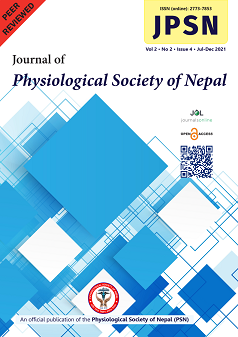Prevalence of prehypertension and its associated risk factors among students of a nursing campus in Nepal
DOI:
https://doi.org/10.3126/jpsn.v2i2.50175Keywords:
Prehypertension, prevalence, nursing studentsAbstract
Introduction: Prehypertension is an early indicator of hypertension and subsequently the increased risk factor for cardiovascular diseases in later years of life. Prevalence of prehypertension and hypertension was found to be higher among adults in Nepal. However it is not much explored among the young population focusing on gender, hence requiring more studies to control it efficiently. Thus, this study aims to determine the prevalence of prehypertension and its associated risk factors among nursing students.
Materials and methods: A cross-sectional study was conducted among the nursing students of Nepalgunj Nursing Campus, Banke, Nepal. Blood pressure measurement and anthropometric measurement was done for data collection. Descriptive analysis, Pearson correlation and chi square test was done using SPSS v20.
Results: Total 189 female nursing students participated whose mean age was 22.06±3.42 years. Only 21 participants (11.1%) had prehypertension. Out of total, 36 (19%) were overweight and 11 (5.8%) were obese; 56 (29.6%) had a high waist hip ratio and 75 (39.7%) of the participants had family history of hypertension. There was no significant association of prehypertension with body mass index, waist hip ratio and family history of hypertension. However, the systolic blood pressure was moderately and positively correlated with waist circumference (r=0.215, p=0.003), hip circumference (r=0.222, p=0.002) and body mass index (r=0.237, p=0.001) but not with waist-hip ratio. Similarly, the diastolic blood pressure was also moderately and positively correlated with waist circumference (r=0.309, p<0.001), hip circumference (r=0.269, p<0.001), body mass index (r=0.269, p<0.001) and waist hip ratio (r=0.178, p=0.014).
Conclusions: Although the prevalence of prehypertension among nursing students is low and there are no significantly associated risk factors, blood pressure is still correlated with the anthropometric measurements.
Downloads
Downloads
Published
How to Cite
Issue
Section
License
Copyright (c) 2021 Journal of Physiological Society of Nepal

This work is licensed under a Creative Commons Attribution-NonCommercial 4.0 International License.

